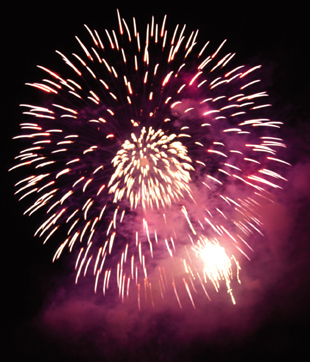Hack 36 Secrets of Fireworks Photography
| < Day Day Up > |
| Don't let any smoke get in your eyes for this assignment. Stand upwind, bring your tripod, and capture some truly spectacular images . Big fireworks shows are thrilling to watch, and they make thrilling photo subjects. Because it's night photography, you'd think that all of the rules of shooting in low light would apply for this assignment. Ha! This hack wouldn't be necessary if that were so. In my opinion, fireworks photography is counterintuitive. In other words, my guesses for settings are wrong over half the time. But now that I've learned my lessons (through more trial and error than I'd care to admit), I can show you the secrets that can dramatically increase your odds of success. 3.9.1 What to Bring with YouYour chances of getting a great shot improve greatly if you have the right equipment. First, you need a camera that allows you to control the shutter speeds and aperture. Technically, you could use a little "auto-everything" cheapie, but it is such a pain in the fuse that it's hardly worth it. If you don't have a camera with decent manual controls, you might want to make friends with someone who does. Next , you need to bring your tripod, a remote shutter release (if you have one), your red-bulb flashlight, a black piece of cardboard or baseball cap, and whatever outdoor gear you'll need to be comfortable. 3.9.2 Location, Location, LocationI know your first inclination will be to get as close as possible to the action. Resist that urge. Fireworks are all about perspective. Find a location that enables you to photograph the explosions without having to point your camera directly upward. Often, the best place to shoot is a ways back, and up a bit too if you can find such a position. Sometimes, a hill or atop a parking garage is the ideal place. As you scout for the perfect spot, pay attention to which way the wind is blowing. You don't want to be engulfed in smoke when the heavy artillery gets underway (see Figure 3-13). Figure 3-13. Fireworks and smoke Here's another good hint: if there's any way you can arrange to have water in the foreground, such as a lake or reflecting pool, you'll capture some wild effects, as illustrated in Figure 3-14. Figure 3-14. Fireworks over water 3.9.3 Setting Up Your CameraPut your camera on the tripod and compose your shot to include the area in which you think the fireworks are going to appear. Leave the ISO setting at 100; this is one of those counterintuitive things. While this is technically night shooting, the fireworks produce plenty of light, so there's no need to increase image noise in the dark areas of the sky by raising the ISO setting. Now, set your aperture to f-8even more counterintuitiveness, I'm afraid. If you were to open it up all the way to something like f-2.8, something you're probably inclined to do, your fireworks would actually be overexposed , thereby producing that sickening feeling in your stomach and waves of bitter disappointment. Avoid all of that by starting with f-8. However, you do need to set a nice, long shutter speed. Start with four seconds or so. You might have to play with this setting a bit as the shoot progresses, but this should get you going. Finally, I like the white balance set on Daylight, because it produces a nice, warm glow. Other photographers I know swear by using the Tungsten setting to cool things off a bit. It's your call, because it's really a matter of taste. 3.9.4 Taking the ShotsOnce the fireworks begin, take some initial shots. You want to anticipate the action. When you think a series is about to begin, put the black cardboard or baseball cap over your lens and trip the shutter. As the explosions begin, quickly pull back the cardboard and let the camera capture the action. I like this technique because you can control the cardboard faster than you can the camera. Digicams are notorious for shutter lag, and what you need here is pure responsiveness. Whoever thought that cardboard would outperform a sophisticated digital device? But wait, there's more. What if you want to create a multiple-exposure shot that includes many bursts of fireworks? Just set the shutter to a really long time, like 30 seconds, and then control the exposures with the cardboard. As the fireworks explode, move the cardboard aside. Put it back over the lens until the next series appears, and then remove it again. This way, you won't overexpose the image with the ambient light in the scene; you'll record only the bursts of fireworks. What you're really doing is creating a multiple-exposure shot. Try it; it's really fun. 3.9.5 Final ThoughtsThe techniques I've outlined here are starting points. Review your pictures in the LCD monitor and adjust accordingly . If your fireworks aren't bright enough, open up the aperture one stop (e.g., go from f-8 to f-5.6). If they are too bright, close down the aperture one stop (e.g., f-8 to f-11). Play with multiple exposures by using the black-cardboard technique. Or, if you want to keep things simple, just set the shutter at four seconds or so and fire away without the cardboard. There's lots of room for creativity here. Have a blast! |
| < Day Day Up > |
EAN: 2147483647
Pages: 161